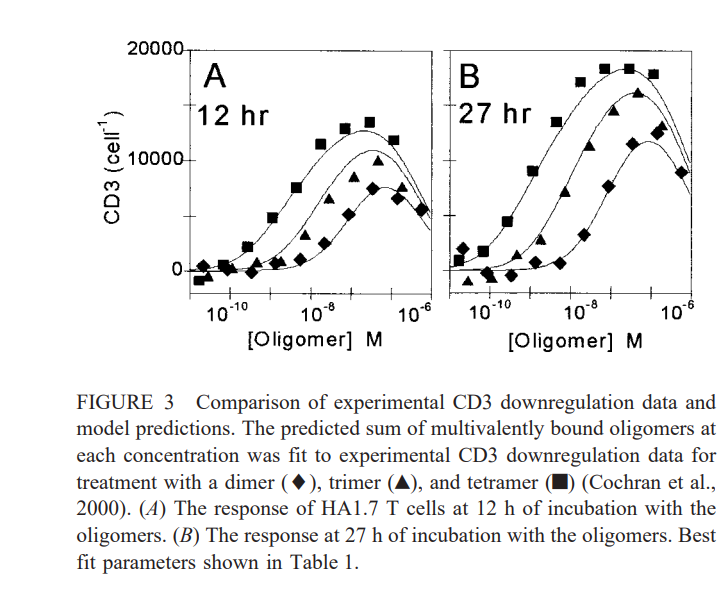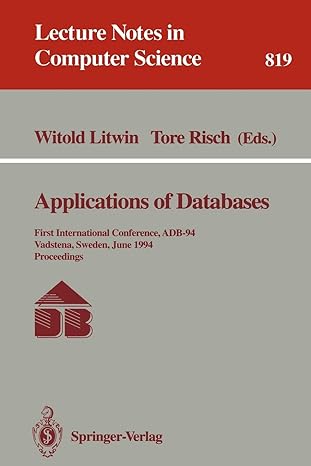Question
%matplotlib inline import matplotlib.pyplot as plt import numpy as np from scipy.special import binom from scipy.optimize import least_squares np.seterr(over='raise') def StoneMod(Rtot, Kd, v, Kx, L0):

%matplotlib inline
import matplotlib.pyplot as plt
import numpy as np
from scipy.special import binom
from scipy.optimize import least_squares
np.seterr(over='raise')
def StoneMod(Rtot, Kd, v, Kx, L0):
'''
Returns the number of mutlivalent ligand bound to a cell with Rtot
receptors, granted each epitope of the ligand binds to the receptor
kind in question with dissociation constant Kd and cross-links with
other receptors with crosslinking constant Kx. All eq derived from Stone et al. (2001).
'''
v = np.int_(v)
assert L0.shape == v.shape
# Mass balance for receptor species, to identify the amount of free receptor
diffFunAnon = lambda x: Rtot-x*(1+v*L0*(1/Kd)*(1+Kx*x)**(v-1))
## Solve Req by calling least_squares
lsq = least_squares(diffFunAnon, np.full_like(L0, Rtot/2.0), jac_sparsity=np.eye(L0.size),
max_nfev=1000, xtol=1.0E-10, ftol=1.0E-10, gtol=1.0E-10,
bounds=(np.full_like(L0, -np.finfo(float).eps), np.full_like(L0, Rtot)))
if lsq['cost'] > 1.0E-8:
print(lsq)
raise RuntimeError("Failure in solving for Req.")
Req = lsq.x
Lbound = np.zeros(Req.size)
Rmulti = np.zeros(Req.size)
Rbnd = np.zeros(Req.size)
for ii, Reqq in enumerate(Req):
# Calculate vieq from equation 1
vieq = L0[ii]*Reqq*binom(v[ii], np.arange(1, v[ii] + 1))*np.power(Kx*Reqq, np.arange(v[ii]))/Kd
# Calculate L, according to equation 7
Lbound[ii] = np.sum(vieq)
# Calculate Rmulti from equation 5
Rmulti[ii] = np.dot(vieq[1:], np.arange(2, v[ii] + 1, dtype=np.float))
# Calculate Rbound
Rbnd[ii] = Rmulti[ii] + vieq[0]
return (Lbound, Rbnd, Rmulti)
Xs = np.array([8.1E-11, 3.4E-10, 1.3E-09, 5.7E-09, 2.1E-08, 8.7E-08, 3.4E-07, 1.5E-06, 5.7E-06, 2.82E-11, 1.17E-10, 4.68E-10, 1.79E-09, 7.16E-09, 2.87E-08, 1.21E-07, 4.5E-07, 1.87E-06, 1.64E-11, 6.93E-11, 2.58E-10, 1.11E-09, 4.35E-09, 1.79E-08, 7.38E-08, 2.9E-07, 1.14E-06])
Ys = np.array([-196, -436, 761, 685, 3279, 7802, 11669, 12538, 9012, -1104, -769, 1455, 2693, 7134, 11288, 14498, 16188, 13237, 988, 1734, 4491, 9015, 13580, 17159, 18438, 18485, 17958])
Vs = np.repeat([2, 3, 4], 9)
#### We will fit the data contained within Fig. 3B. Plot this data and describe the relationship you see between Kx, Kd, and valency. Python.
FIGURE 3 Comparison of experimental CD3 downregulation data and model predictions. The predicted sum of multivalently bound oligomers at each concentration was fit to experimental CD3 downregulation data for treatment with a dimer (), trimer (), and tetramer ( ) (Cochran et al., 2000). (A) The response of HA1.7 T cells at 12h of incubation with the oligomers. (B) The response at 27h of incubation with the oligomers. Best fit parameters shown in Table 1Step by Step Solution
There are 3 Steps involved in it
Step: 1

Get Instant Access to Expert-Tailored Solutions
See step-by-step solutions with expert insights and AI powered tools for academic success
Step: 2

Step: 3

Ace Your Homework with AI
Get the answers you need in no time with our AI-driven, step-by-step assistance
Get Started


